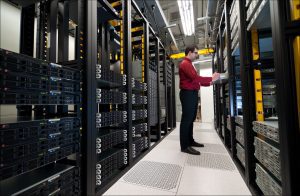Hospitals are unique environments where we care for our most vulnerable population: patients. We are relatively successful at creating hospital structures that protect patients from powerful forces of nature such as earthquakes and floods. However, we are far less effective at protecting patients from the myriad of unseen hazards that lie inside the hospital. Patient injury from medical errors and new infections acquired during in-patient treatment, called adverse patient events (APEs) are unacceptably costly to both patient health and hospital budgets. By integrating smart building technologies, hospitals can provide a safer healing environment and avoid needless spending.
Hospitalized patients are at risk for potentially disastrous consequences from sub-optimal environment conditions and infrastructure systems, such as:
- Time-pressured and fatigued clinical staff
- Noisy mechanical equipment and diagnostic tools
- Overloaded hospital and physician data management systems
Perhaps the biggest threat to patient health and hospital budgets however are infections that patients acquire while in the hospital, called healthcare-associated infections (HAIs). The pathogens responsible for these infections are increasingly resistant to the strongest antibiotics and are continually evolving to reproduce, despite harsh growth conditions created by antibiotics, room cleaning solutions, and filters and UV lights in ventilation systems. The organisms that survive these forces are extremely virulent, and can cause deadly infections if accidentally transmitted to patients through staff or visitor contact, air currents carrying pathogen-laden aerosols, or in food and water.
Invisible hospital hazards, such as HAIs, are difficult to monitor and control, however, it is essential that we do so to save patient lives and prevent unnecessary healthcare expenses. Thoughtful hospital design can improve patient healing and save millions of dollars as shown in, “The Human Hospital: How to Create an Autonomic Nervous System for Your Facility.” This white paper investigates the sources of errors leading to APEs and suggests modeling the hospital’s infrastructure to mimic the human autonomic nervous system (ANS), a part of the central nervous system.
The ANS maintains healthy physiology by continuously monitoring body systems, alerting the conscious mind only when action is needed to prevent a crisis. In an analogous way, intelligent building automation, used to optimize hospital energy consumption and mechanical systems, can be configured to monitor additional hospital infrastructure and human activities associated with patient harm. This so-called “hospital ANS” creates an intelligent hospital infrastructure that can alert staff to correct unseen errors before patients are injured, thereby preventing HAIs and other APEs in the same way that the ANS protects the human body. For example, in addition to many additional benefits, an intelligent hospital infrastructure could optimize and integrate systems in the following ways:
- HVAC systems can be optimized to reduce the spread of airborne diseases.
- Video surveillance can be integrated with hand-hygiene solutions to encourage proper hand sanitization.
- Generator testing solutions can ensure backup power is always available to protect patient lives.
These intelligent infrastructure solutions could not only improve your patient care, but can also save your hospital millions of dollars every year. Using the following calculation, if a 250-bed hospital implemented a hand-hygiene solution which reduced HAIs by 25%, that hospital could save nearly $23 million in related costs in 1 year.
- HAI in-patient prevalence = 8.5% of all admissions
- HAI rate per bed per year = 4.53
- Cost per HAI = $91,733
- HAI cost per bed per year = $415,700
- Savings per bed per year with hand-hygiene solution if 25% reduction in HAI’s = $103,800
(The average occupancy rate for hospitals globally is 80% with the average length of stay of 4.838 days.25 This allows 60.36 annual admissions per bed, or 292 annual patient-days per bed. Calculation: [365 days/year / 4.838 days/admission] = 60.36 admissions/year)



Conversation
You actually make it seem really easy with your presentation but I to
find this matter to be actually one thing that I think I would
never understand. It seems too complex and extremely vast for me.
I am taking a look forward on your next publish,
I will attempt to get the hold of it!